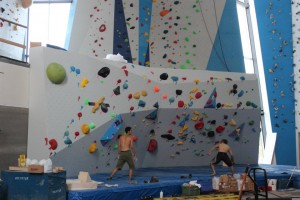Ongoing Pre-Comp Coverage of IFSC Hamilton, June 1-2: The Art of World Cup Routesetting
If you think that set up for an IFSC comps are a higher-level version of what may be available at your local gym, think again. Competition setting has very different and specific goals than training routes and circuits in a commercial gym.


If you think that setting for IFSC comps is a higher-level version of what may be available at your local gym, think again. Competition setting has very different and specific goals than training routes and circuits in a commercial gym.
First and foremost, the problems need to be difficult enough to challenge the competitors and create separation. But the level of difficulty has to be just right, too hard and no one can do the problems; too easy and everyone sends, either way you won’t get the separations needed to rank the competitors.
But separation is merely a basic requirement for a successful competition. A good setter will also create a mix of problems that test a variety of skill sets (in no particular order: technique, balance, flexibility, route reading and strength) so that the best climber emerges as the victor, not just the specialist in a particular genre such as pinches or slabs. It’s also important to create problems that are not overly height-dependent. Finally, aesthetically pleasing and exciting moves are required for the spectators. Route setters have a complex task requiring a finely-honed sense of judgement to balance all the different elements.
As the highest level of the sport, World Cups have a strict and formalized set of requirements for to produce a victor and put on a good show. The IFSC rules for setters are clearly set out: each route must have a designated finishing hold or a defined standing position at the top and a bonus hold. None of the problems can be more than 12 holds long and the number of handholds has to be between four and eight. The lowest part of the problem must never be more than three metres above the ground.
Using holds to test and split up the best competitors in the world and end up with a clear winner requires rare knowledge of climbing, holds and comp formats.
In fact, not just anyone can set at these comps. There must be at least two IFSC certified comp setters. You must be a national setter already in your home country to even qualify for the IFSC routesetter course. Then you have to serve a five World Cup unpaid setting internship to fully qualify.
The chief setter at IFSC Hamilton is Jamie Cassidy from Liverpool, England, who has been setting for ten years. He is accompanied by Martin Hammerer of Austria.
We had a brief conversation with Cassidy a few days before the comp.
Gripped: What is the first principle of setting for these comps?
Jamie Cassidy: They must be fair, given everyone’s height.
Gripped: What is the hardest part in setting today?
Jamie Cassidy: Qualifier routes to split up the best climbers are hardest. We watch the climbers and then try to adjust our plans for the second qualifiers and then finals. We aim for a spectacle in the finals, but also variety, a slab can be just as spectacular as a dyno, in a different way.
Gripped: What are the challenges in the future?
Jamie Cassidy: Everyone is getting stronger and stronger so routes need to be harder and harder as well. It’s exciting.


